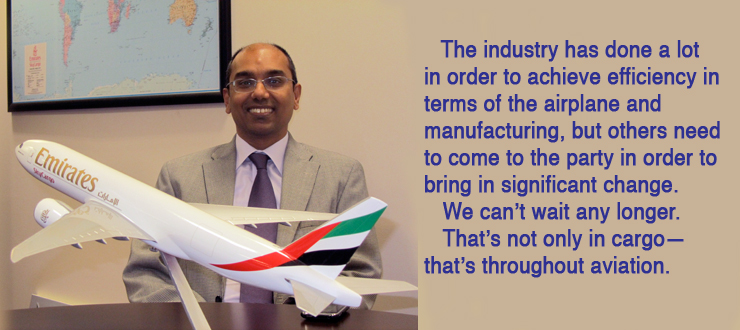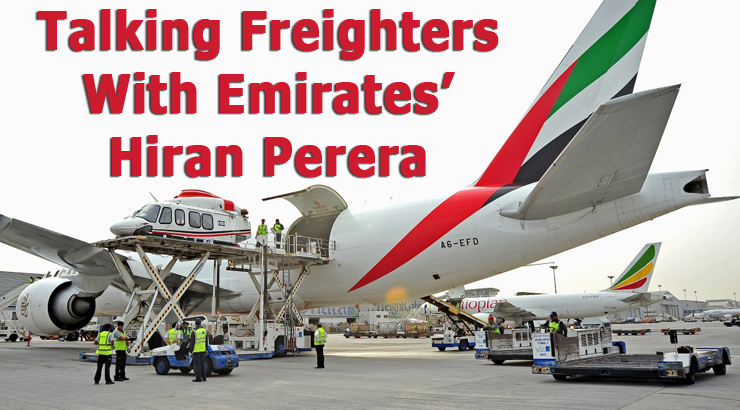EK Freighters Big Sky
|
(Dubai Exclusive)—Hiran
Perera, Emirates Senior Vice President Cargo Planning & Freighters,
is a long-standing veteran of all-cargo aircraft—the relationship
has been ongoing since 1994.
|
 |
“As we go on with more freighters
coming in, there’s obviously more risk, and therefore more complexity
of operation, which at one time was mainly Europe/Asia centric and is
now more global.
“We cover the globe both ways, transatlantic,
transpacific. Because of the divider markets, it’s become more
complex. Each market reacts or acts differently, or is impacted differently.
“Over the years you see crises that
take place; for example the Ash cloud in Europe or what happened in
Japan, and you have to manage things differently.
“We look more into the passenger
belly operation and look at that synergy—we use to do it before,
but now more structurally, to look at the cost of the belly operation
and put more science behind that.
“Some aircraft bellies, as long
as the aircraft are operating within the maximum range, they are fine;
you can get the maximum payload.
“We view B777-300ERS as freighters
in disguise. SkyCargo can carry 20-25 tons of freight with a full load
of passengers – that’s more than on some full freighters.
Emirates now operates fifty-four of these 300ers, and we were one of
the initial customers for the 300ers.
“Our team actually drove the cargo
aspect of that B777 and quite a few others, including the A380 and A330-200—we
pushed the manufacturers to enhance the offering and capability of the
airplanes for air cargo.
“For us the issue is that we have
these airplanes operating shorter- and medium-haul sectors, but we also
have our long-range operations.
“Those longer stage lengths get
beyond the maximum range of the airplane to carry a lot of air cargo,
but because B777 is so great, the economics are so good, and because
that is the kind of airplane that, from a passenger perspective, is
suitable for those routes, we do operate them to places from Dubai like
Sao Paolo, San Francisco, Los Angeles, etc.
“But with cargo capacity compromised,
we need to manage that as well. This is why we look more closely at
the equation; as our fleets and belly capacity have evolved, we need
to identify more clearly what our true belly capacity is as one of the
key elements of what we do.
“It’s all about about optimizing
our assets for the organization.”
The A380 has long been heralded as a new
wave passenger plane, but the question moving forward for both the A380
and the air cargo community is whether the A380 can work for the cargo
community.
“It remains to be seen whether the
Airbus can offer service as a freighter, because that variant was scrapped.
Now in 2011 things have changed; the A380 cargo offering will have to
be completely different, because today the B777 does the job.
“We have 15 A380s in the fleet and
it’s a great airplane. The cargo capability of the airplane is
much better than we expected it to be. We are able to carry 13-15 tons
on average on the A380.
“We worked closely with Airbus in
order to optimize the underbelly cargo capacity, and that’s paid
off. We had to push them to make some design changes; for example we
specified the ability to carry pallets in what we call the tunnel area—the
area in between the gear.
“The original specs only allowed
for containers, and that volume is very beneficial when you have a full
passenger load. When these are operating on air lanes like Heathrow,
Paris or Incheon, that freight capability is important. With that volume,
we are now able to achieve 13-15 tons and have even gone up to 18 tons
depending on the density of the freight.”
In terms of the evolutionary cycle of
developing more capacity as new airplanes come online, Hiran Perera
admits that he was involved in the early stages of the A380 development.
“Ram (Menen) and I worked quite
a bit in order to get that belly capacity. We are happy to see that
it’s actually benefitting us.
“As we go along, we’ll do
that with new aircraft that come in as well, working with manufacturers
to ensure that belly capacity.
“For an airline like us, the freight
in the belly is extremely important, you cannot understate the importance
of it. It represents 17+ percent of our business.
“Also working with the passenger
business requires deep dish understanding of what their seasonality
is, so that we can optimize and ensure that the available capacity is
utilized.
“You have seasonality of freight
and also have seasonality of passenger demand, and we have good data
surrounding both. So using that data and the systems more effectively,
you can leverage your assets quite well.
“With SkyChain, we have that capability
to be flexible and bring in all the data. SkyChain is a brilliant system.
“Worth noting is that on the passenger
side there are various systems as well. So integrating inputs provides
us the information that is needed for making decisions.
“It’s been a team effort.
I don’t really get involved on the system side of things, but
what the teams have been able to achieve is brilliant.
“For myself I am particularly proud
of keeping tabs on the cost side of things, identifying freighter related
costs, etc. Having all of the costs available in the system so that
you have up to date costs, and having revenue information available
so that you can forecast ahead of time what is going to happen, and
what needs to be done is critical to our success.
“Capacity is perishable –
being in the industry for time immemorial, I know that.
“Having information early, you know
what costs will be, what expected forecasted revenue will be based on
volumes, and to see ahead of time what you can do to redress that.
“Reality dictates that you can’t
tell how freighter costs will fall in the long-term, so that’s
why we’re putting our focus on using the data in the short- to
medium-term to see if we need to change things.
“As example maybe we need to combine
some points in order to protect load factor, volumes, etc.
“You have to weigh that up against
your schedule integrity, customer commitments – find a way to
bring all this together in order to deliver the service levels and not
compromise any service levels, and at the same time make sure you are
agile enough to manage the volatility to which we are all subject.”
Listening to Hiran, it’s easy to
see how others can look to Emirates for answers. We wonder, given all
of Emirates’ success, whether there is anyone they need look to.
“We watch all the competitors, and
I think what we’ve created is a unique response to what we have
learned from the industry.
“What is unique about the Emirates
organization is that it is a team, and we have a great team with great
leadership, and that’s set us apart from everyone else.
“I don’t think you can replicate
what we do here. It’s the coming together of these different individuals
as a team, and it’s evolved over the last 25 years into something
that is extremely special.
Big Lift Down Under Emirates SkyCargo added weekly
B777F inaugural service on its new Far East and Australasia freighter
route, Dubai-Singapore-Sydney-Hong Kong-Dubai. |
“I want to address an aspect of
our business that may get less attention—air charters. Emirates
developed the charter business over the years; it doesn’t run
separately, it runs within the freighter unit. We’ve found it’s
proven to be absolutely invaluable to do that – it brings in a
different stream and you can manage the cyclical nature of our business
and take advantage of it.
“Our unique global position helps
as well, we can take advantage of opportunities around us."
The Fertile Crescent earned its moniker
for a reason—Emirates’ unique proximity offers a bountiful
vantage point on the rest of the world, and the company is not shy about
taking advantage of that.
“Right now the charter markets that
intrigue us are Africa and Japan.
“We’ve not been able to take
advantage of the Japan market as much as we would like to.
“We continually look at new routes
and new business; earlier this year, for example, we launched twice-weekly
freighter service to Iraq—that’s a scheduled operation.”
In terms of expanding SkyCargo into a
second hub, Mr. Perera said:
“At this point we’ve shied
away from creating any new hubs. Dubai is our key hub because of the
interaction between the freighters and the passenger belly and how it
feeds in and out.
“But, never say never in this business!
We are open to anything.
“We started freighter services a
year ago last month (October) to South America, but the cost of fuel
is quite challenging. We pay more for fuel here than in Europe or Asia.
“I also want to mention that responsibility
for all of the components in the freighters—including their environmental
impact—is an ongoing collective responsibility here. At the outset
we decided that we needed to look at new fuel-efficient airplanes, industry
leading airplanes that are also environmentally friendly.
“But broadening environmental issues
a bit, if you look at green initiatives, mostly getting efficiency in
the airway systems would go a long way.
“Look at the congested airports
in Europe. You get overhead on time and then you spend time in the hold—that
is not environmentally friendly.
“The industry has done a lot in
order to achieve efficiency in terms of the airplane and manufacturing,
but others need to come to the party in order to bring in significant
change.
“We can’t wait any longer.
“That’s not only in cargo—that’s
throughout aviation.
“For us in air cargo, the B777s
provide us the best of everything, by far, and that’s why we have
a strategy surrounding B777s as the future.
“We have more aircraft delivering
this year; in August we received an airplane, in February 2012 we will
receive our fourth B777F airplane, and we expect to get more as we go
along.
“That is going to be the backbone
of our fleet.
“We’ll have the most efficient, most environmentally friendly
freighter fleet going forward. Can’t say it enough—the B777
is a great airplane from all aspects.
“In terms of containers we’ve
trialed a lot of new technology – lightweight containers that
would bring the overall weight down, research into weight on the airplanes
and where weight can be shed. In the 777s there was an initiative that
was part of the design of the airplane that would change out the rigid
cargo barrier, which would save weight on the airplane.
“We look at ways that will reduce
weight on the airplanes as well, some of which gets specified because
it’s an airplane for a larger community, and if you don’t
need certain things, then we need to remove them to shed weight.
“For example, there is a certain
type of lock we won’t use for efficiency reasons.
“If you can shave 10 minutes in
holding, 10 minutes off of taxiing, waiting in line to take off, the
amount of fuel you save brings more efficiency in the system, cuts emission
and reduces costs.
“Everyone along the chain must get
on board,” Hiran Perera said.
We couldn’t agree more. And we rest
assured that Hiran will remain diligent in his post, lulling the turbid
waves of air cargo into passive submission.
Geoffrey/Flossie
Bangkok
Floods Keep
|
Get
On Board Air Cargo News FlyingTypers |
Celebrating Wolfie Els
|
If
You Missed Any Of The Previous 3 Issues Of FlyingTypers |
|||||
|
|||||
FT110711 |
FT111411 |
||||
|---|---|---|---|---|---|






 “We
are counting on our 25 offices abroad to give the right information
about the flood situation in Thailand,” said Tourism Authority
of Thailand (TAT) Governor Suraphon Svetasreni (left) at the Foreign
Correspondents Club of Thailand (FCCT) last week.
“We
are counting on our 25 offices abroad to give the right information
about the flood situation in Thailand,” said Tourism Authority
of Thailand (TAT) Governor Suraphon Svetasreni (left) at the Foreign
Correspondents Club of Thailand (FCCT) last week. 
 We
are deeply saddened to learn that Wolfgang Els (known as Wolfie to many)
passed away on Tuesday, November 8, 2011.
We
are deeply saddened to learn that Wolfgang Els (known as Wolfie to many)
passed away on Tuesday, November 8, 2011.

